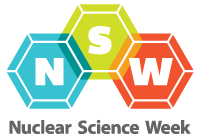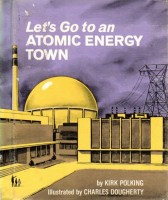Nuclear Waste Storage - Two Perspectives
Written by Will Davis on location at the ANS 2015 Winter Meeting

A message from Goodway Technologies
Optimizing Maintenance Strategies in Power Generation: Embracing Predictive and Preventive Approaches
Written by Will Davis on location at the ANS 2015 Winter Meeting
 The third day of National Nuclear Science Week is focused upon the production of energy by nuclear means-and that means energy that can do work for man. Electric power, steam for heating businesses and homes, and mechanical power for propelling ships are perhaps the best known examples of man's use of nuclear energy.
The third day of National Nuclear Science Week is focused upon the production of energy by nuclear means-and that means energy that can do work for man. Electric power, steam for heating businesses and homes, and mechanical power for propelling ships are perhaps the best known examples of man's use of nuclear energy.
Shortly before midnight on September 26, 1944, a sustained chain reaction was begun for the first time in a nuclear reactor whose purpose was not merely to prove that fission could be achieved or sustained. The brand new reactor at Hanford Engineer Works, Washington state, had only been complete for about a month; its first uranium fuel had begun loading only on September 13. Incredibly, this facility, of a nature that had never been attempted before (as man had only been aware of fission, itself, for less than a decade) was built in the incredible time span of 11 months; ground had been broken to build the reactor building in October 1943.
 In February, the U.S. Department of Energy finally announced the approval of a federal loan guarantee for the Vogtle-3 and -4 reactor project under construction near Waynesboro, Ga. The approval came after four years of negotiations between the government and the utilities involved in the Vogtle project.
In February, the U.S. Department of Energy finally announced the approval of a federal loan guarantee for the Vogtle-3 and -4 reactor project under construction near Waynesboro, Ga. The approval came after four years of negotiations between the government and the utilities involved in the Vogtle project.
 In the 1960s, visions for nuclear power were hopeful and plentiful; nuclear plants of all sorts imaginable* were under consideration and under construction in areas both urban and remote, while future plans portrayed an enormous nuclear plant build-out with a complete fuel cycle that included fuel recycling and breeder reactors.
In the 1960s, visions for nuclear power were hopeful and plentiful; nuclear plants of all sorts imaginable* were under consideration and under construction in areas both urban and remote, while future plans portrayed an enormous nuclear plant build-out with a complete fuel cycle that included fuel recycling and breeder reactors.
 A United States appellate court recently handed down two long-awaited rulings with respect to Yucca Mountain. As most observers expected, both decisions were decidedly in nuclear's favor.
A United States appellate court recently handed down two long-awaited rulings with respect to Yucca Mountain. As most observers expected, both decisions were decidedly in nuclear's favor.
Moniz on Nuclear
Breaking the used nuclear fuel logjam?
 The US Department of Energy has a $452 million program to share development and licensing costs for selected small modular reactor (SMR) designs. The DOE's goal is to have an operating SMR by ~2022. Last November, the DOE awarded the first grant to the B&W mPowerTM reactor. In more recent news, the DOE has decided to issue a follow-on solicitation to enter a similar cost-sharing agreement with one or more other SMR vendors (and their SMR designs). The status of development and licensing for several SMR designs are summarized below.
The US Department of Energy has a $452 million program to share development and licensing costs for selected small modular reactor (SMR) designs. The DOE's goal is to have an operating SMR by ~2022. Last November, the DOE awarded the first grant to the B&W mPowerTM reactor. In more recent news, the DOE has decided to issue a follow-on solicitation to enter a similar cost-sharing agreement with one or more other SMR vendors (and their SMR designs). The status of development and licensing for several SMR designs are summarized below.
Taxpayers for Common Sense on February 27 issued a press release targeting the Department of Energy for "wasting more than half a billion dollars" on its small modular reactor (SMR) development cost-sharing program. Leaving aside the historically essential role of government investment in developing, advancing, and bringing to market innovative energy technologies-and the fact that early government investments in nuclear energy technology now pay back enormous dividends to all Americans in billions of dollars' worth of affordable and emission-free electricity generation every year-many of the advantages of advanced SMR energy technologies were overlooked or misconstrued in the group's press release and policy brief.
 This month's post discusses my ideas on an issue I've been thinking about for awhile. Although we have four new reactors under construction in the United States (at Vogtle and Summer), the nuclear "renaissance" has so far not been nearly as strong as many had hoped. This begs the question as to what is holding nuclear back.
This month's post discusses my ideas on an issue I've been thinking about for awhile. Although we have four new reactors under construction in the United States (at Vogtle and Summer), the nuclear "renaissance" has so far not been nearly as strong as many had hoped. This begs the question as to what is holding nuclear back.
Plus a few pointers to what's in store for 2013
A joint Department of Energy and NASA team has demonstrated a simple, robust fission reactor prototype [note: see Comments for more accurate and complete description] intended for development for future space exploration missions. The DUFF (Demonstration Using Flattop Fissions) experiment represents the first demonstration in the United State-since 1965-of a space nuclear reactor system to produce electricity.
Robert Alvarez has issued another misleading report about energy dense fuel materials, titled Managing the Uranium-233 Stockpile of the United States.
 Several important events have recently occurred involving the U.S. Nuclear Regulatory Commission, the Yucca Mountain nuclear waste repository, and the interactions between the two.
Several important events have recently occurred involving the U.S. Nuclear Regulatory Commission, the Yucca Mountain nuclear waste repository, and the interactions between the two.
Getting the NRC license is just the first step
Westinghouse gets support from Missouri for 225-MW reactor
On Friday, March 30, American Nuclear Society President Eric Loewen submitted outside written testimony on behalf of the American Nuclear Society to the U.S. House Appropriations Subcommittee on Energy and Water Development. The testimony addresses on Fiscal Year (FY) 2013 appropriations for the U.S. Department of Energy (DOE) and other relevant agencies under the Subcommittee's jurisdiction-in particular, funding for nuclear programs under DOE's Office of Nuclear Energy.
 After giving a brief update on recent Fukushima-related events in the United States, I'd like to talk about some good (but relatively unpublicized) things that have happened during what has otherwise been a very challenging year for the nuclear industry. Then I'll discuss what, to me, was the most disconcerting story in the past year.
After giving a brief update on recent Fukushima-related events in the United States, I'd like to talk about some good (but relatively unpublicized) things that have happened during what has otherwise been a very challenging year for the nuclear industry. Then I'll discuss what, to me, was the most disconcerting story in the past year.
Steven A. Arndt, Ph.D., P.E., cited as best engineer in federal service